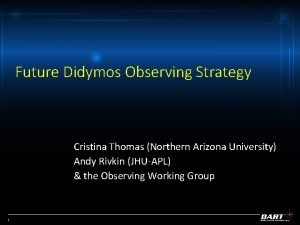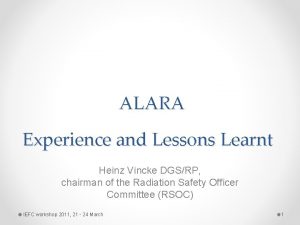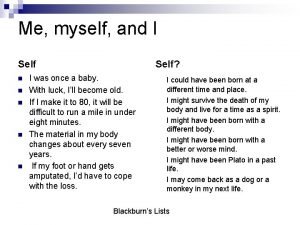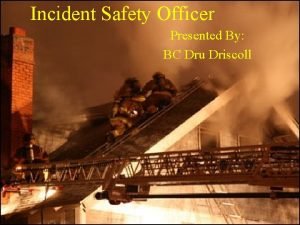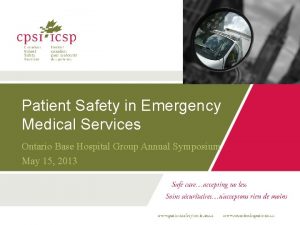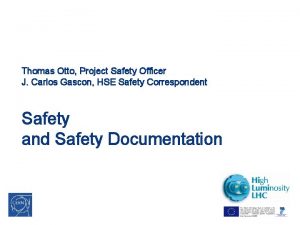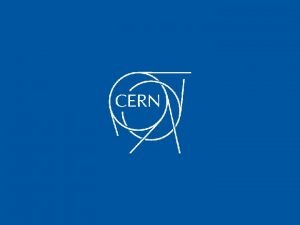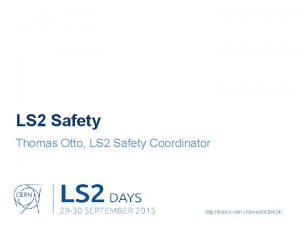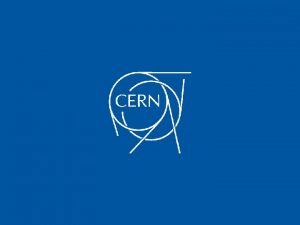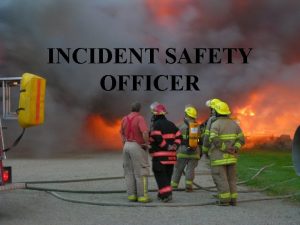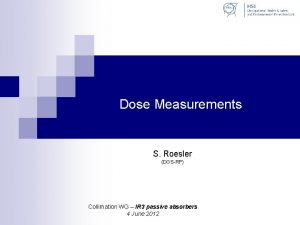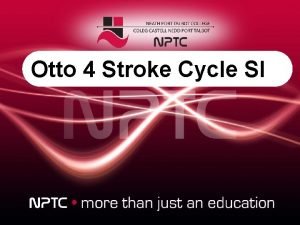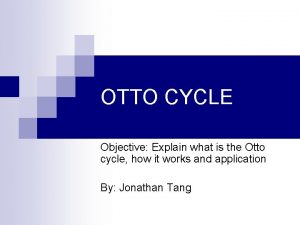Thomas Otto TE Safety Officer Cristina Adorisio DGSRP



















- Slides: 19


Thomas Otto, TE Safety Officer Cristina Adorisio, DGS-RP (Radiation Protection Aspects) Safety and Radiation Protection 3 rd Splice Review, 12. – 14. 11. 2012

Contents SMACC and the LHC as a pressure vessel II. Health and Safety during SMACC work I. SUVA Method for Risk Assessment II. CERN Operational Procedures III. High risk operations and controls IV. Radiation protection aspects I. III. Safety Training for LS 1 and SMACC

SMACC and the LHC as a pressure vessel • • • LHC is an existing equipment Harmonized standard (EN ISO 13458) not available at time of construction Components subject to pressure were designed to standards CODAP and CODETI SMACC is a repair, not a modification Therefore, all pressure-vessel related quality and safety criteria follow the “old” standards

Health & Safety during SMACC work • Based on a Hazard Register and a Risk Assessment , no consequences Hazard + (exposure*consequence) = Risk

SUVA Method for Risk Assessment SUVA – Swiss professional accident insurance and prevention organism • Start with systematic classification of Workplace hazards • N. 1 2 Hazardous Phenomenon Mechanical a Unprotected moving elements Hazards b Dangerous surfaces and edges c Moving vehicles and machines Trip, Slip and Fall hazards And so on d Uncontrolled moving elements e f a b c d e Fall of objects Fluids under pressure Working at height Level differences Slippery surfaces Disorder Visibility […. ] Exemples Zones d’écrasement, de cisaillement, de choc, de coupure, de perforation, d’entraînement, de happement Coins, angles, pointes, arrêts vives, rugosités Accrochage, heurt, basculement, écrasement, chute, rampes, déclivité Basculement, balancement, roulement, glissement ou projection d’éléments Gas, vapour, oil, Ladders, platforms, ramps Steps, opening in floor Snow, ice, soiled or wet floors Fog, smoke, dust

Risk Scale • Very simple approach, gauged to the project: • • • Low risk: worker suffers minor injury, without consequence for himself and for the project Medium risk: worker suffers minor injury, without consequence for himself, but project progress may be delayed as a consequence of the accident High risk: Worker may suffer permanent incapacity as a consequence of an accident

CERN Operational Procedures Detailed work instructions for all project phases • Made for the end-user (worker) • Main source of safety-relevant information • Chap. 1. 1 1. 2 2 3. 1 3. 2 4. 1 4. 2 5 Avtivité Sub-activity Ouverture manchette Démontage Manchette W W Installation des soupapes de décharge DN 200 Contrôle qualité écrans thermiques Ouverture manchette Installation des protections M Découpe soudure manchettes M Dépose Isolation Capture soufflet M busbar Dépose isolation interconnexion Quality Control of the LHC Main Interconnection Contrôle qualité Splices produced before LS 1 (before Application of brasure Shunts) And so on […] EDMS 1236329 1236232 1227123 1198420 1198424 1240298 Ver. 0. 1 0. 2 1. 1 5 5 0. 1 Baseline LHC-QBBI-IP-0017 LHV-QBBI-IP-0016 LHC-QBBI-IP-0014 -00 -70 LHC-QBBI-IP-0011 -00 -40 LHC-QBBI-TP-0006 v. 0. 1

Risk assessment method • • • Identify the hazards inherent in the operational procedures, according to SUVA systematics Estimate the risk (L/ M/ H) without controls Describe the controls already in place Are controls appropriate and sufficient ? If not, recommend additional controls

Specific High-Risk Operations Risk Operation Control Mechanical Risks Cutting, shear, abrasion, Work with machine tools entanglement CE-cert. tools, personal protective equipment (PPE) Projection of liquids Hydraulic tools Systematic inspection of tools Moving machines Brazing and soldering machines Arrest manual brakes Hazardous substances Flux vapours Brazing, soldering Local exhaust ventilation (LEV), PPE Metal vapours (Pb, Sn) Brazing, soldering low T << 500 o. C, LEV, workplace monitoring : negative result

Specific High-Risk Operations (cont. ) Risk Operation Control Noise Mechanical tooling operations, compressors, PPE UV light TIG welding Welder’s mask and clothes Magnetic field Induction brazing machine Off-limits for pace-maker and defibrillator bearers Lighting Visual quality control Portable projectors Physical Constraints Muscular-skeletal disorders Handling of heavy loads Pumps, machine tools, bellows … Correct posture, team work, mechanical aids

High Risk operations common to all SMACC phases Risk Control Hazardous substances Alcohol for cleaning: toxic and flammable PPE, Tunnel ventilation, reduction of quantity Multi-layer insulation fire Extinguishers present during hot work Work Organization Unfamiliarity with workplace Team building, several weeks run-up period Language barrier Basic French lessons, Phrasebook, Identification of interpreters Repetitive work, lack of decision margin Vary tasks, change roles, small teams Lack of qualification Thorough on-the-job training Road Transport Safety Information campaign (flyer)

Radiation Protection Aspects • The LHC Arcs show marginal radiation hazard: • • Ambient dose equivalent rate H*(10) < 0. 5 m. Sv h-1 Radioactivity nearly always < exemption limit

Radiation Protection Aspects (2) • Nevertheless, RP controls imposed: • • • LHC classified as radiation area RP safety briefing Personal dosimeter All waste treated as potentially radioactive Sealed vacuum cleaners, emptied by RP in glove box RP support staff at each access pit during both SMACC shifts

Radiological classification of areas – 2013 Point 4 Point 5 Point 6 Point 3 For the LS 1 ü LHC tunnel mostly classified as Supervised Radiation Area üFew areas might be classified as Simple Controlled Radiation Area Point 2 üCollimation and dump areas will be classified as Limited Stay Area Point 1 Point 8 Point 7

Formal Safety Training for LS 1 and SMACC The following table is simplified for staff and associated members of personnel. Contractor’s safety training is largely the employer’s responsibility. Training Comment Form Initial Safety Briefing With the TE DSO Trainer CERN Safety Level 1 Basic site safety Web LS 1 Safety Condensed from CERN Safety level 2 -4 Web Electrical Safety Awareness For non-electricians Web Electrical qualification French “Habilitation” for electricians Trainer RP Safety Briefing Self-Rescue Mask Web With practical exercises Trainer

Role of the Supervisors In the CERN hierarchy, the responsibility of the supervisor includes safety aspects • Supervisors shall be • • • Informed of hazards, risks and controls Verify the application of procedures Correct hazardous behaviour, if necessary Report dangerous situations Go ahead as a good example of safe behaviour

Summary High-Risk operations in SMACC have been identified and controls found appropriate • Additional controls for common risks are in preparation • Radiation protection aspects are fully covered • Safety Training is essential • • • formal and on-the-job Full implication of Supervisors is important

 Cristina thomas
Cristina thomas Dgsrp
Dgsrp Ottote
Ottote Dgsrp
Dgsrp Me myself and i self concept
Me myself and i self concept Consumer safety officer
Consumer safety officer Dru driscoll
Dru driscoll Canadian patient safety officer course
Canadian patient safety officer course Axon officer safety plan
Axon officer safety plan Forensic anthropologist vs forensic pathologist
Forensic anthropologist vs forensic pathologist What is catzoc
What is catzoc Qbs safety care
Qbs safety care Personal safety vs process safety
Personal safety vs process safety Ind safety report
Ind safety report Basic safety (construction site safety orientation)
Basic safety (construction site safety orientation) Basic safety construction site safety orientation
Basic safety construction site safety orientation Dottoressa cristina manzi contatti
Dottoressa cristina manzi contatti Maria cristina cataudella
Maria cristina cataudella Cristina pennarola
Cristina pennarola Cristina itu
Cristina itu
